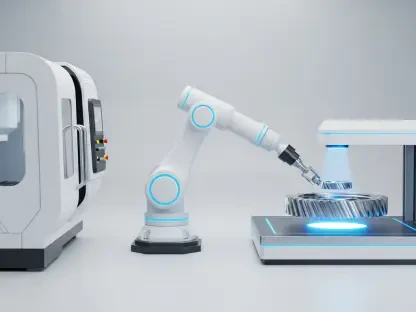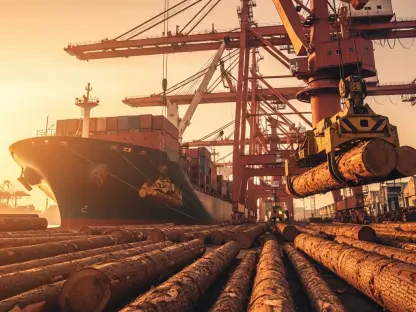The construction industry is a cornerstone of the global economy, influencing urban and rural landscapes by creating jobs, stimulating economic growth, and shaping the environments where people live, work, and play. Within this dynamic field, three critical components stand out: construction dumpsters, HVAC (Heating, Ventilation, and Air Conditioning) systems, and electrical projects. These elements are essential for the successful completion and functionality of any building project, reflecting the industry’s complexity and ongoing evolution.
Construction Dumpsters
Importance of Efficient Waste Management
Efficient waste management is crucial in construction, and construction dumpsters are central to this process. These large containers are designed to handle massive amounts of debris and waste materials generated on construction sites. The United States plays a significant role in this sector, accounting for approximately 20% of the global dumpster rental market. This statistic underscores the scale at which waste management services operate within the construction industry. Keeping sites clean and orderly not only boosts efficiency but also reduces hazards that can impede progress.
The need for efficient waste management highlights the importance of having the right equipment, such as construction dumpsters, to handle the significant volumes of waste generated. The presence of these dumpsters facilitates the organized sorting and disposal of materials, mitigating the risk of regulatory violations and potential fines. The logistical aspect of waste management is often underestimated but plays a pivotal role in ensuring that construction projects remain on schedule and within budget. Proper usage of these dumpsters results in fewer interruptions and helps maintain a safer working environment.
Environmental Compliance and Sustainability
Dumpsters not only provide practical advantages by keeping worksites clean and organized, but they also help construction companies comply with environmental regulations. Proper sorting and disposal of waste minimize the environmental footprint of construction activities, supporting sustainability efforts and enhancing operational efficiency. Construction projects generate various types of waste, including hazardous materials, which require careful handling to protect the environment and comply with stringent regulations.
Some companies are now adopting best practices for waste management, such as recycling and reusing certain materials, which not only reduces waste but also conserves resources and minimizes environmental impact. The use of specialized dumpsters for different types of waste can streamline this process, making recycling and proper disposal more manageable. By prioritizing sustainability, construction companies can improve their environmental performance while also meeting regulatory requirements. This approach not only benefits the planet but often results in cost savings and improved project outcomes.
Technological Advancements in Dumpsters
Technological advancements have made modern dumpsters more adaptable and efficient. These innovations cater to the evolving needs of the construction industry, with a focus on convenience and accessibility. The latest designs align with trends towards eco-friendly practices and operational efficiency, reflecting a broader movement towards sustainability within the sector. Advanced features, such as built-in compaction capabilities and smart sensors for monitoring fill levels, enhance the usability and efficiency of modern dumpsters.
The integration of technology helps construction companies track waste management practices in real time, providing data that can be used to optimize operations and reduce overall waste. These advancements also facilitate the implementation of more sustainable practices, as the data collected can highlight areas for improvement and drive more effective recycling and disposal strategies. In addition, the use of GPS and telematics systems allows for better route planning and logistics, reducing fuel consumption and emissions during the transportation of dumpsters.
HVAC Systems
Essential Role in Indoor Environments
Heating, ventilation, and air conditioning systems are another critical aspect of the construction industry, essential for creating comfortable and healthy indoor environments in both residential and commercial buildings. Projections by LLCBuddy indicate that over 151 million HVAC systems will be supplied globally in 2024, reflecting the growing demand for these vital systems. The need for maintaining optimal indoor air quality and temperature control is paramount, as these factors significantly affect occupant comfort and productivity.
The installation of HVAC systems requires a deep understanding of building design and engineering principles to ensure they operate effectively and efficiently. As buildings become more complex and energy-efficient, so too do the requirements for HVAC systems. Construction projects must integrate these systems seamlessly into the overall design, ensuring they meet both performance standards and regulatory requirements. The importance of HVAC systems cannot be overstated, as they play a key role in the daily lives of occupants, influencing health, well-being, and overall quality of life.
Skilled Labor and Technical Knowledge
The widespread adoption of HVAC systems highlights the necessity for skilled labor and technical knowledge, driving job growth and emphasizing the importance of vocational training and continued education in this field. As construction techniques and materials evolve, so too must the methodologies for installing and maintaining HVAC systems. The demand for qualified HVAC technicians is rising, reflecting the industry’s reliance on skilled professionals to meet the growing needs of modern construction projects.
Training programs and certifications play an essential role in ensuring that HVAC technicians are equipped with the latest knowledge and skills necessary to handle advanced systems and technologies. Ongoing education is crucial as new materials, techniques, and regulatory standards continually emerge. By investing in the development of their workforce, construction companies can maintain high standards of installation and maintenance, ensuring the longevity and reliability of HVAC systems. This focus on technical expertise enhances the overall quality and performance of the buildings being constructed.
Energy Efficiency and Innovation
Energy efficiency is a significant driving force behind advancements in HVAC technology. Modern systems are designed to reduce energy consumption and carbon emissions, appealing to environmentally conscious consumers and complying with regulatory measures aimed at reducing environmental impact. Consequently, HVAC systems represent a convergence of innovation, necessity, and sustainability within the construction industry. Innovative features such as variable speed motors, smart thermostats, and advanced control systems improve energy efficiency and provide greater control over indoor environments.
The development of green building standards and certification programs has further accelerated the adoption of energy-efficient HVAC systems. These standards encourage the use of technologies and practices that reduce energy use, lower greenhouse gas emissions, and promote the overall sustainability of buildings. As more consumers and businesses prioritize sustainability, the demand for energy-efficient HVAC systems continues to grow. This trend underscores the important role of HVAC systems in achieving broader environmental goals and shaping the future of the construction industry.
Electrical Projects
Demand for Skilled Electricians
Electrical components are indispensable for the functionality and safety of any construction project. The demand for skilled electricians is increasing, with over 625,000 currently employed in America and nearly 715,000 projected by 2024, according to the Bureau of Labor Statistics. This surge is indicative of the diverse range of electrical projects involved in construction, from simple wiring to complex installations. The critical role of electricians encompasses not only the installation of electrical systems but also their maintenance and troubleshooting, ensuring continuous and safe operation.
The growing complexity of electrical systems in modern buildings, including smart technologies and renewable energy integrations, underscores the need for comprehensive training and expertise. Electricians must stay abreast of the latest advancements and regulatory changes to provide safe and effective electrical services. As technology continues to evolve, the skills required for electrical work expand, making vocational training and professional development more important than ever. This focus on skilled labor ensures that electrical systems meet current standards and are capable of supporting future innovations.
Planning and Execution for Safety
Electrical projects require meticulous planning and execution to ensure safety and efficiency. Electricians are pivotal in providing the power necessary for operating various systems and appliances within buildings. Innovations in electrical technology have led to smarter and more sustainable solutions, highlighting the essential role of electricians in integrating these advancements into construction practices. Detailed planning is crucial to address the various challenges and obstacles that can arise during electrical installations, from preventing overloading circuits to ensuring proper grounding and insulation.
Successful electrical project execution depends on precise coordination and adherence to safety protocols, which mitigate the risk of accidents and ensure reliable operation. Construction projects often involve multiple trades working simultaneously, requiring electricians to communicate effectively and collaborate with other professionals to avoid conflicts and delays. Safety remains a top priority, with strict regulatory requirements governing electrical work to protect both workers and building occupants. By following these regulations and best practices, electricians contribute to the overall success and safety of construction projects.
Integration of New Technologies
The integration of new technologies such as smart grids and renewable energy sources drives progress towards a more sustainable future. Electricians are on the frontline of incorporating these technologies, ensuring that buildings are equipped to meet current and future demands. This reflects a symbiotic relationship between traditional construction roles and modern technological advancements. Building automation systems, electric vehicle charging stations, and energy storage solutions are examples of the innovations that electricians are now installing and maintaining.
Smart grid technology enables more efficient energy distribution and management, reducing waste and enhancing the reliability of electrical systems. Renewable energy integrations, such as solar panels and wind turbines, require specialized knowledge for proper installation and optimization. Electricians’ role in these projects is critical, as they ensure that new technologies are seamlessly integrated into existing infrastructure. By embracing these advancements, electricians help construction move towards a more sustainable and energy-efficient future.
Common Themes and Key Points
Emphasis on Sustainability
The article presents a cohesive narrative that emphasizes the vital roles of construction dumpsters, HVAC systems, and electrical projects within the construction industry. A common theme is the emphasis on sustainability and the growing importance of environmentally friendly practices. Advancements in technology across all three areas enhance operational efficiency and reduce environmental impacts, aligning with broader industry trends. The commitment to sustainability drives innovation, encouraging the development and adoption of practices and technologies that minimize environmental harm while improving overall performance.
The construction industry is embracing sustainable materials, energy-efficient systems, and waste reduction techniques, reflecting a broader cultural shift towards environmental responsibility. This shift is supported by regulatory frameworks and incentives that reward sustainable practices, making it more economically viable for companies to adopt green solutions. By prioritizing sustainability, the industry not only meets the demands of environmentally conscious consumers but also contributes to global efforts to combat climate change and protect natural resources.
Technological Innovations
The construction industry is a fundamental pillar of the global economy, significantly impacting both urban and rural landscapes. It plays a vital role by generating jobs, promoting economic growth, and shaping the spaces where people live, work, and engage in recreational activities. Within this multifaceted sector, three essential components stand out: construction dumpsters, HVAC (Heating, Ventilation, and Air Conditioning) systems, and electrical projects. These elements are crucial for the successful completion and operational efficiency of any construction project.
Construction dumpsters are indispensable for managing waste and debris, ensuring a clean and safe work environment. HVAC systems are critical for maintaining comfortable indoor climates, which is essential for both residential and commercial buildings. Electrical projects are the backbone of modern construction, providing the necessary infrastructure for power and communication systems. Together, these components reflect the complexity and ever-evolving nature of the construction industry, highlighting its ability to adapt and innovate to meet contemporary needs and challenges.









